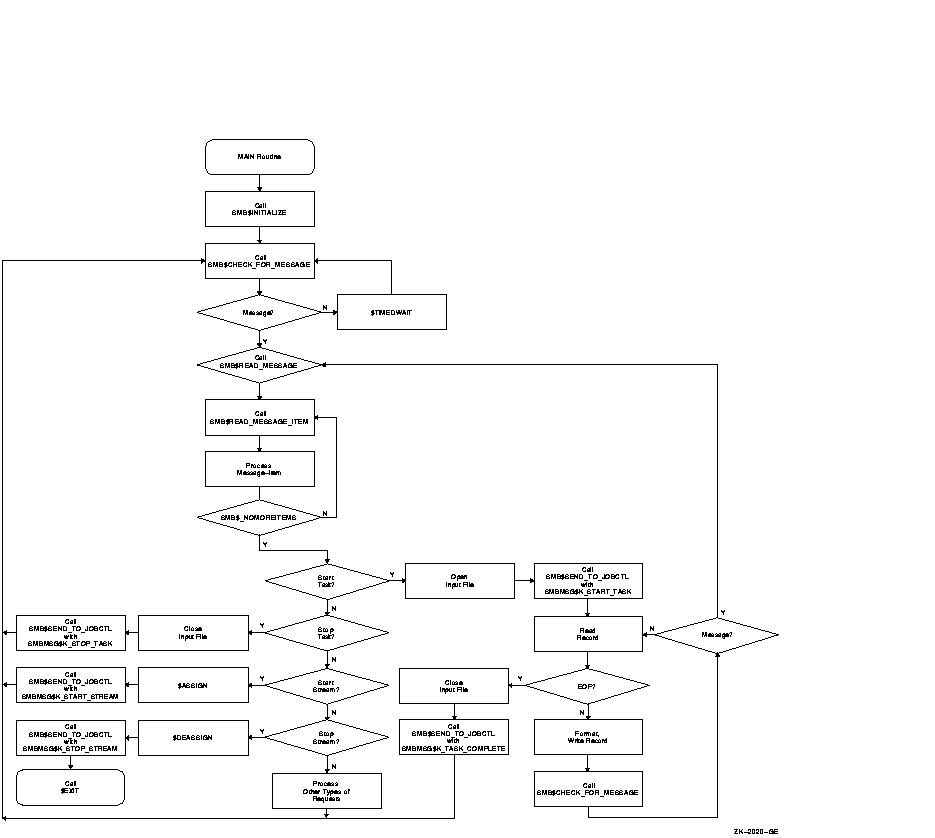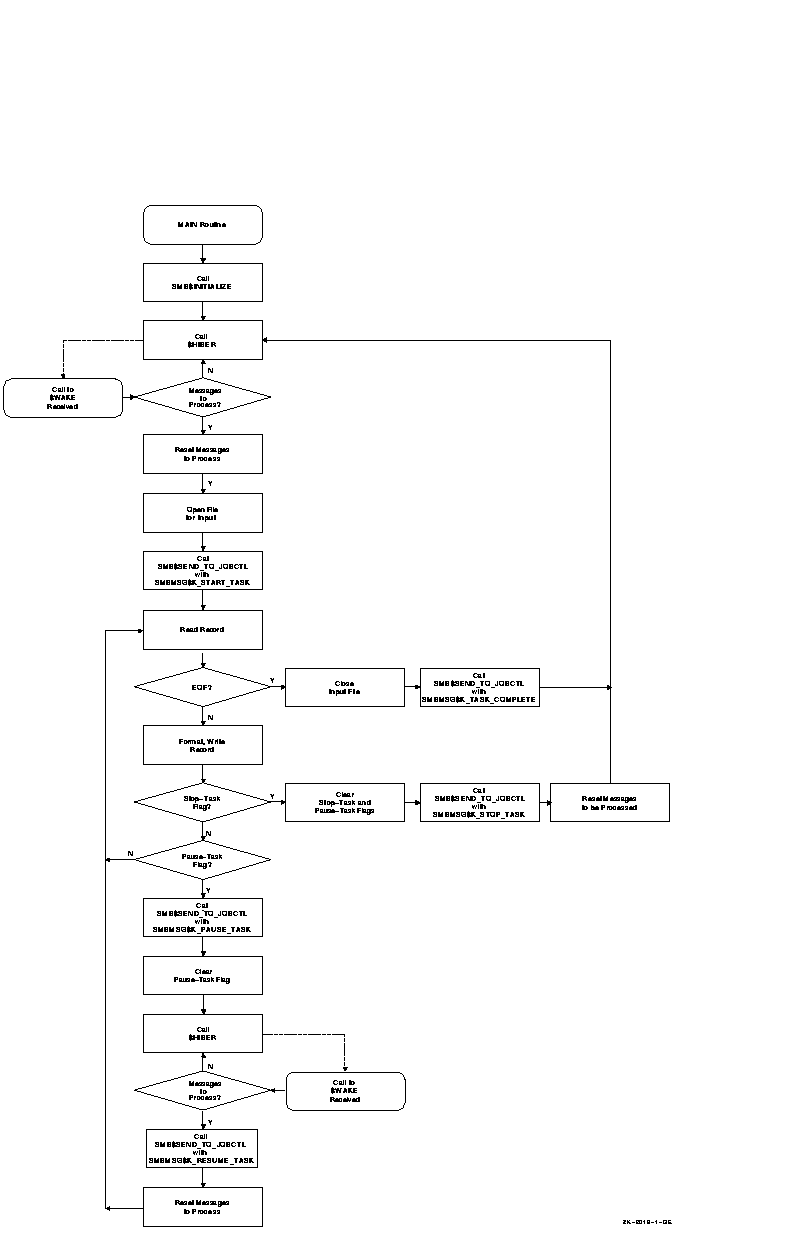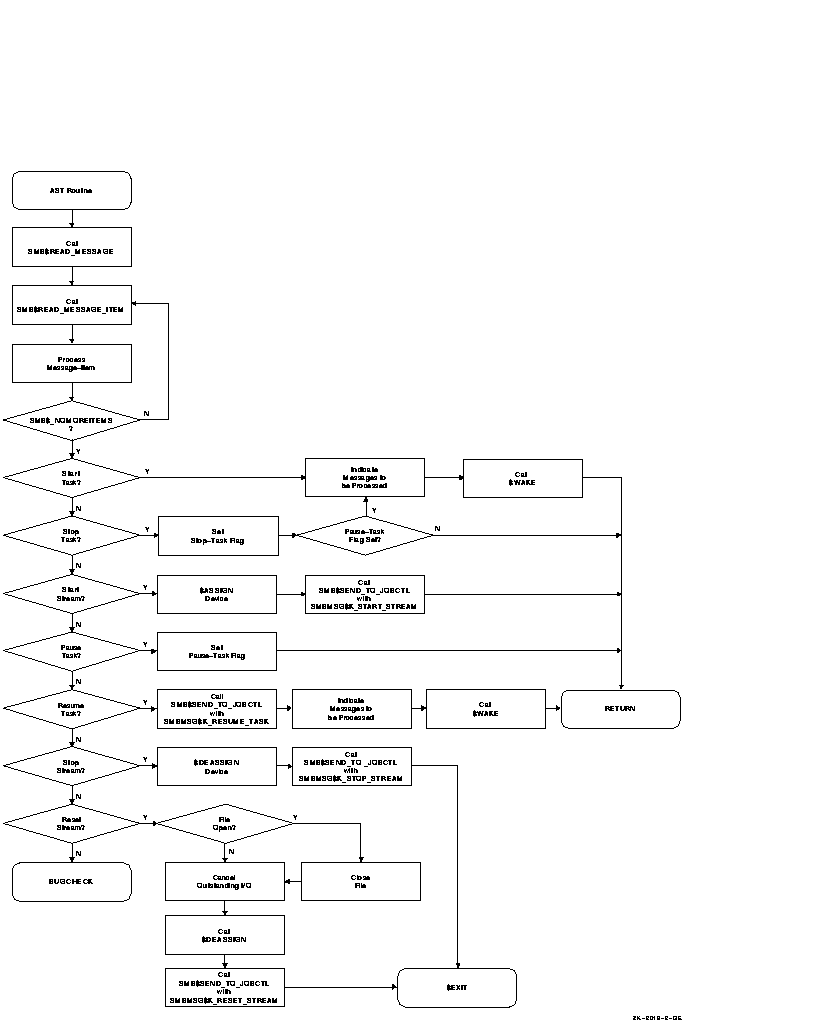![[Compaq]](../../images/compaq.gif)
![[Go to the documentation home page]](../../images/buttons/bn_site_home.gif)
![[How to order documentation]](../../images/buttons/bn_order_docs.gif)
![[Help on this site]](../../images/buttons/bn_site_help.gif)
![[How to contact us]](../../images/buttons/bn_comments.gif)
![[OpenVMS documentation]](../../images/ovmsdoc_sec_head.gif)
| Document revision date: 19 July 1999 | |
![[Compaq]](../../images/compaq.gif) |
![[Go to the documentation home page]](../../images/buttons/bn_site_home.gif)
![[How to order documentation]](../../images/buttons/bn_order_docs.gif)
![[Help on this site]](../../images/buttons/bn_site_help.gif)
![[How to contact us]](../../images/buttons/bn_comments.gif)
|
![[OpenVMS documentation]](../../images/ovmsdoc_sec_head.gif)
|
|
| Previous | Contents | Index |
When you initialize your symbiont/job controller interface, the symbiont has the option of accepting requests from the job controller sychronously or asynchronously.
The address of an AST routine is an optional argument to the SMB$INITIALIZE routine; if it is not specified, the symbiont receives messages from the job controller synchronously. A symbiont that receives messages synchronously must call SMB$CHECK_FOR_MESSAGE periodically during the processing of tasks in order to ensure the timely delivery of STOP_TASK, PAUSE_TASK, and RESET_STREAM requests.
SMB$CHECK_FOR_MESSAGE checks to see if a message from the job controller is waiting. If a message is waiting, SMB$CHECK_FOR_MESSAGE returns a success code. The caller of SMB$CHECK_FOR_MESSAGE can then call SMB$READ_MESSAGE to read the message and take the appropriate action.
If no message is waiting, SMB$CHECK_FOR_MESSAGE returns a zero in R0. The caller of SMB$CHECK_FOR_MESSAGE can continue to process the task at hand.
Figure 16-2 is a flowchart for a synchronous, single-threaded symbiont. The flowchart does not show all the details of the logic the symbiont needs and does not show how the symbiont handles PAUSE_TASK, RESUME_TASK, or RESET_STREAM requests.
Figure 16-2 Flowchart for a Single-Threaded, Synchronous Symbiont

To receive messages asynchronously, a symbiont specifies a message-handling AST routine as the second argument to the SMB$INITIALIZE routine. In this scheme, whenever the job controller sends messages to the symbiont, the AST routine is called.
The AST routine is called with no arguments and returns no value. You have the option of having the AST routine read the message within the context of its execution or of having the AST routine wake a suspended process to read the message outside the context of the execution of the AST routine.
Be aware that an AST can be delivered only while the symbiont is not executing within the context of an AST routine. Thus, in order to ensure delivery of messages from the job controller, the symbiont should not perform lengthy operations at the AST level.
This is particularly important to the execution of STOP_TASK, PAUSE_TASK, and RESET_STREAM requests. If a STOP_TASK request cannot be delivered during the processing of a task, for example, it is useless.
One technique that ensures delivery of STOP and PAUSE requests in an asynchronous environment is to have the AST routine set a flag if it reads a PAUSE_TASK, STOP_TASK, or a RESET_STREAM request and to have the symbiont's main routine periodically check the flag.
Figure 16-3 and Figure 16-4 show flowcharts for a single-threaded, asynchronous symbiont. The figures do not show many details that your symbiont might include, such as a call to the $QIO system service.
Note that the broken lines in Figure 16-3 that connect the calls to $HIBER with the AST routine's calls to $WAKE show that the next action to take place is the call to $WAKE. They do not accurately represent the flow of control within the symbiont but represent the action of the job controller in causing the AST routine to execute.
Figure 16-3 Flowchart for a Single-Threaded, Asynchronous Symbiont (MAIN Routine)

Figure 16-4 Flowchart for a Single-Threaded, Asynchronous Symbiont (AST Routine)

A single-stream (or thread) is a logical link between a queue and a symbiont process. When a symbiont process is linked to more than one queue and serves those queues simultaneously, it is called a multithreaded symbiont.
The argument to the SMB$READ_MESSAGE routine provides a way for a
multithreaded symbiont to keep track of the stream referred to by a
request. Writing your own multithreaded symbiont, however, can be a
complex undertaking.
16.1.8 Reading Job Controller Requests
Table 16-1 lists the seven general functions the job controller can request of the symbiont.
| SMBMSG$K_START_STREAM | SMBMSG$K_STOP_STREAM |
| SMBMSG$K_START_TASK | SMBMSG$K_PAUSE_TASK |
| SMBMSG$K_RESUME_TASK | SMBMSG$K_STOP_TASK |
| SMBMSG$K_RESET_STREAM |
The job controller passes these requests to the symbiont in a structure that contains: (1) a code that identifies the requested function and (2) optional items of information that the symbiont might need to perform the requested function.
By calling SMB$READ_MESSAGE, the symbiont reads the function code and writes the associated items of information, if any, into a buffer. The symbiont then parses the message items stored in the buffer by calling the SMB$READ_MESSAGE_ITEM routine. SMB$READ_MESSAGE_ITEM reads one message item each time it is called.
Each message item consists of a code that identifies the type of information the item contains, and the information itself. For example, the SMBMSG$K_JOB_NAME code tells the symbiont that the item contains a string, which is the name of a job.
The number of message items in a request message varies with each type of request. Therefore, to ensure that all message items are read, SMB$READ_MESSAGE_ITEM must be called repeatedly for each request. SMB$READ_MESSAGE_ITEM returns status SMB$_NOMOREITEMS after it has read the last message item in a given request.
Typically, a symbiont checks the code of a message item against a case table and stores the message string in an appropriate variable until all the message items are read and the processing of the request can begin.
See the description of the SMB$READ_MESSAGE_ITEM routine for a table
that shows the message items that make up each type of request.
16.1.9 Processing Job Controller Requests
After a request is read, it must be processed. The way a request is processed depends on the type of request. The following section lists, for each request that the job controller sends to the print symbiont, the actions that the standard symbiont (PRTSMB) takes when the message is received. These actions are oriented toward print symbionts in particular but can serve as a guideline for other kinds of symbionts as well.
The symbiont you write can respond to requests in a similar way or in a different way appropriate to the function of your symbiont. Compaq suggests that your routines follow the guidelines described in this document. (Note that the behavior of the standard symbiont is subject to change without notice in future versions of the operating system.)
A STOP_STREAM request and a RESET_STREAM request each stop the queue; but a RESET_STREAM request is an emergency stop and is used, for example, when the device has failed. A RESET_STREAM request should prevent any further I/O activity because the printer might not be able to complete it. |
The symbiont uses the SMB$SEND_TO_JOBCTL routine to send messages to the job controller.
Most messages that the symbiont sends to the job controller are responses to requests made by the job controller. Such messages inform the job controller that the request has been completed successfully or unsuccessfully. The function code that the symbiont returns to the controller in the call to SMB$SEND_TO_JOBCTL indicates what request has been completed.
For example, if the job controller sends a START_TASK request using the SMBMSG$K_START_TASK code, the symbiont responds by calling SMB$SEND_TO_JOBCTL using SMBMSG$K_START_TASK as the request argument to indicate that task processing has begun. Until the symbiont responds, the DCL command SHOW QUEUE indicates that the queue is starting.
The responses to some requests use additional arguments to send more information than just the request code. See the SMB$SEND_TO_JOBCTL routine for a table showing the additional arguments allowed in response to each request.
In addition to sending messages in response to requests, the symbiont can send other messages to the job controller. In these messages the symbiont sends either the SMBMSG$K_TASK_COMPLETE code, indicating that it has completed a task, or SMBMSG$K_TASK_STATUS, indicating that the message contains information on the status of a task.
Note that, when a START_TASK request is delivered, the symbiont
responds with a SMB$SEND_TO_JOBCTL message with the SMBMSG$K_START_TASK
code. This response means the task has been started. It does not mean
the task has been completed. When the symbiont completes the task, it
calls SMB$SEND_TO_JOBCTL with the SMBMSG$K_TASK_COMPLETE code.
16.2 SMB Routines
This section describes the individual SMB routines.
The SMB$CHECK_FOR_MESSAGE routine determines whether a message sent from the job controller to the symbiont is waiting to be read.
SMB$CHECK_FOR_MESSAGE
OpenVMS usage: cond_value type: longword (unsigned) access: write only mechanism: by value
Longword condition value. Most utility routines return a condition value in R0. Condition values that this routine can return are listed under Condition Values Returned.
None.
When your symbiont calls the SMB$INITIALIZE routine to initialize the interface between the symbiont and the job controller, you can choose to have requests from the job controller delivered by means of an AST. If you choose not to use ASTs, your symbiont must call SMB$CHECK_FOR_MESSAGE during the processing of tasks in order to see if a message from the job controller is waiting to be read. If a message is waiting, SMB$CHECK_FOR_MESSAGE returns a success code; if not, it returns a zero.If a message is waiting, the symbiont should call SMB$READ_MESSAGE to read it to determine if immediate action should be taken (as in the case of STOP_TASK, RESET_STREAM or PAUSE_TASK).
If a message is not waiting, SMB$CHECK_MESSAGE returns a zero. If this condition is detected, the symbiont should continue processing the request at hand.
SS$_NORMAL One or more messages waiting. 0 No messages waiting.
The SMB$INITIALIZE routine initializes the user-written symbiont and the interface between the symbiont and the job controller. It allocates and initializes the internal databases of the interface and sets up the mechanism that is to wake up the symbiont when a message is received.
SMB$INITIALIZE structure_level [,ast_routine] [,streams]
OpenVMS usage: cond_value type: longword (unsigned) access: write only mechanism: by value
Longword condition value. Most utility routines return a condition value in R0. Condition values that this routine can return are listed under Condition Values Returned.
structure_level
OpenVMS usage: longword_unsigned type: longword (unsigned) access: read only mechanism: by reference
Version of the symbiont/job controller interface. The structure_level argument is the address of a longword containing the version of the symbiont/job controller interface used when the symbiont was compiled. Always place the value of the symbol SMBMSG$K_STRUCTURE_LEVEL in the longword addressed by this argument. Each programming language provides an appropriate mechanism for defining symbols.ast_routine
OpenVMS usage: ast_procedure type: procedure value access: read only mechanism: by reference
Message-handling routine called at AST level. The ast_routine argument is the address of the entry point of the message-handling routine to be called at AST level when the symbiont receives a message from the job controller. The AST routine is called with no parameters and returns no value. If an AST routine is specified, the routine is called once each time the symbiont receives a message from the job controller.The AST routine typically reads the message and determines if immediate action must be taken. Be aware that an AST can be delivered only while the symbiont is operating at non-AST level. Thus, to ensure delivery of messages from the job controller, the symbiont should not perform lengthy operations at AST level.
If you do not specify the ast_routine argument, the symbiont must call the SMB$CHECK_FOR_MESSAGE routine to check for waiting messages.
streams
OpenVMS usage: longword_unsigned type: longword (unsigned) access: read only mechanism: by reference
Maximum number of streams the symbiont is to support. The streams argument is the address of a longword containing the number of streams that the symbiont is to support. The number must be in the range of 1 to 32.If you do not specify this argument, a default value of 1 is used. Thus, by default, a symbiont supports one stream. Such a symbiont is called a single-threaded symbiont.
A stream (or thread) is a logical link between a queue and a symbiont. When a symbiont is linked to more than one queue, and serves those queues simultaneously, it is called a multithreaded symbiont.
Your symbiont must call SMB$INITIALIZE before calling any other SMB routines. It calls SMB$INITIALIZE in order to do the following:
- Allocate and initialize the SMB facility's internal database.
- Establish the interface between the job controller and the symbiont.
- Determine the threading scheme of the symbiont.
- Set up the mechanism to wake your symbiont when a message is received.
After the symbiont calls SMB$INITIALIZE, it can communicate with the job controller using the other SMB routines.
SS$_NORMAL Normal successful completion. SMB$_INVSTRLEV Invalid structure level.
This routine also returns any codes returned by $ASSIGN and LIB$GET_VM.
The SMB$READ_MESSAGE routine copies a message that the job controller has sent into the caller's specified buffer.
SMB$READ_MESSAGE stream ,buffer ,request
OpenVMS usage: cond_value type: longword (unsigned) access: write only mechanism: by value
Longword condition value. Most utility routines return a condition value in R0. Condition values that this routine can return are listed under Condition Values Returned.
stream
OpenVMS usage: longword_unsigned type: longword (unsigned) access: write only mechanism: by reference
Stream number specifying the stream to which the message refers. The stream argument is the address of a longword into which the job controller writes the number of the stream referred to by the message. In single-threaded symbionts, the stream number is always 0.buffer
OpenVMS usage: char_string type: character string access: write only mechanism: by descriptor
Address of the descriptor that points to the buffer into which the job controller writes the message. SMB$READ_MESSAGE uses the Run-Time Library string-handling (STR$) routines to copy the message into the buffer you supply. The buffer should be specified by a dynamic string descriptor.request
OpenVMS usage: identifier type: longword (unsigned) access: write only mechanism: by reference
Code that identifies the request. The request argument is the address of a longword into which SMB$READ_MESSAGE writes the code that identifies the request.There are seven request codes. Each code is interpreted as a message by the symbiont. The codes and their descriptions follow:
SMBMSG$K_START_STREAM Initiates processing on an inactive symbiont stream. The job controller sends this message when a START/QUEUE or an INITIALIZE/QUEUE/START command is issued on a stopped queue. SMBMSG$K_STOP_STREAM Stops processing on a started queue. The job controller sends this message when a STOP/QUEUE/NEXT command is issued, after the symbiont completes any currently active task. SMBMSG$K_RESET_STREAM Aborts all processing on a started stream and requeues the current job. The job controller sends this message when a STOP/QUEUE/RESET command is issued. SMBMSG$K_START_TASK Requests that the symbiont begin processing a task. The job controller sends this message when a file is pending on an idle, started queue. SMBMSG$K_STOP_TASK Requests that the symbiont abort the processing of a task. The job controller sends this message when a STOP/QUEUE/ABORT or STOP/QUEUE/REQUEUE command is issued. The item SMBMSG$K_STOP_CONDITION identifies whether this is an abort or a requeue request. SMBMSG$K_PAUSE_TASK Requests that the symbiont pause in the processing of a task but retain the resources necessary to continue. The job controller sends this message when a STOP/QUEUE command is issued without the /ABORT, /ENTRY, /REQUEUE, or /NEXT qualifier for a queue that is currently printing a job. SMBMSG$K_RESUME_TASK Requests that the symbiont continue processing a task that has been stopped with a PAUSE_TASK request. This message is sent when a START/QUEUE command is issued for a queue served by a symbiont that has paused in processing the current task.
Your symbiont calls SMB$READ_MESSAGE to read a message that the job controller has sent to the symbiont.Each message from the job controller consists of a code identifying the function the symbiont is to perform and a number of message items. There are seven codes. Message items are pieces of information that the symbiont needs to carry out the requested function.
For example, when you enter the DCL command PRINT, the job controller sends a message containing a START_TASK code and a message item containing the specification of the file to be printed.
SMB$READ_MESSAGE writes the code into a longword (specified by the request argument) and writes the accompanying message items, if any, into a buffer (specified by the buffer argument).
See the description of the SMB$READ_MESSAGE_ITEM routine for information about processing the individual message items.
SS$_NORMAL Normal successful completion. LIB$_INVARG Routine completed unsuccessfully because of an invalid argument.
This routine also returns any of the condition codes returned by the Run-Time Library string-handling (STR$) routines.
| Previous | Next | Contents | Index |
![[Go to the documentation home page]](../../images/buttons/bn_site_home.gif)
![[How to order documentation]](../../images/buttons/bn_order_docs.gif)
![[Help on this site]](../../images/buttons/bn_site_help.gif)
![[How to contact us]](../../images/buttons/bn_comments.gif)
|
| privacy and legal statement | ||
| 4493PRO_047.HTML | ||